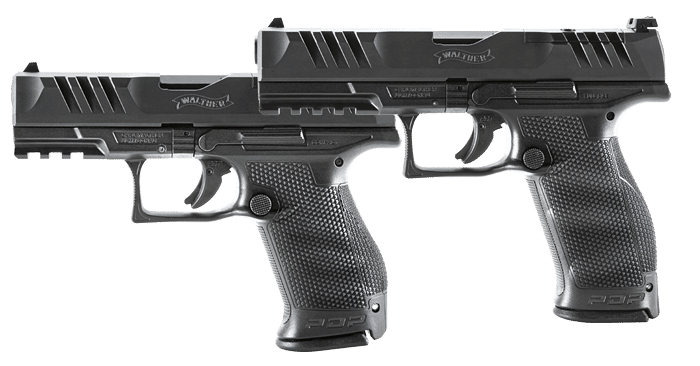In this episode of shooting with NOIR, the guys from Walther bring me their latest and greatest modular handgun, the Walther PDP. I put the Walther PDP through its paces and talk everything Walther. I also get some tips on shooting a handgun with a red dot.
Excerpt From Video:
We got the latest and greatest, the new Performance Duty Pistol (PDP). This gun culminates everything we’ve learned over the past 135 years in ergonomics/pistol design and both functions.
We really looked at why people carry guns and how they use them. We took everything that we’ve learned through the steel frame guns and through the PPQ and put it into this next-generation gun, so you know the grip is our performance duty texture.

There is a lot more grip and traction on them. On our super terrain serrations, the optics cut is lowered down in the slide some so you can really almost co-witness on several different optics right out of the gate.
We took the best striker fire trigger on the market and made it even better with our new performance duty trigger. We’ve lightened up that first stage and made that wall you know you hit it a lot harder. You will certainly see out on the range you can tell it’s just an unbelievable trigger.
We’ve changed the ergonomics a bit to accommodate for shooting with a red dot. There are several people transitioning from an iron sight gun to a red dot. There is an angle on the grip of the gun and when you grip it with your pinky it pulls that red dot right into the eye box.
You’re able to pick that dot up a lot quicker. The entire gun from the texture of the ergonomics is just built around shooting with a red dot. Finding the red dots are all about pinky pressure. Whenever a right-handed shooter points a dot, they’re going to be high and to the left.
It’s going to be one of the two, so one way to knock out the high thing is squeezing your pinky dress. To help that out we put the ergonomics in there; we’re calling them red dot ergonomics to help you pick the dot up a little faster.
When you naturally squeeze the gun, it pulls the fulcrum down, so you find your dot. The other way to cancel out the left is using your natural bind from your body. This helps when you hit a point past your toes you feel your body bind up a little, just like in sports.
We use that to our advantage with a red dot. If I’m going to draw and aim at that guy, I’m going to point my toe right at it and then torque my body. I max out and my body is going to feel it. It doesn’t let me go too far to the left, so you do that with that pinky and the dot will be there every time. t’s a nice little feature. We were very red dot-focused on this bit.
I can tell somebody, “you know it’s hard to find a dot when you’ve been shooting.” Hunting for the dot is annoying. It happens still even if you know what you’re doing.
You’ve heard the whole argument “you do the same thing with iron sights” but you could see the iron sights to fix them but if you know that as a red dot shooter next time you go up and you lose it squeeze your pinky, you’ll find the dot. It’s a pretty crazy little technique
I don’t know if it’s a self-fulfilling prophecy that’s kind of right…
It’s a little weird the little things in life because I want to call bull; I can’t, although, it’s always like the marketing lingo so you know we all sit around and think of all these cool names.
I use different stances depending on what I’m shooting for a match. If we’re shooting a lot of different targets moving, I want the wider stance where I can get in and out pretty quick.
On the other hand, if I’m drawing when I come up on a competitive stage and I have to draw to put shots on the first target, my foot’s getting aimed that way. I know when I draw, I’m not going to be looking for the dot, I can just draw and put rounds on it.
So how much of the PVP? What’s the split between the way that this being focused on self-defense versus the competition? It was there like a conscious effort to go one way or the other or I would say self-defense.
But a high-performance pistol is a high-performance pistol and there shouldn’t be a line between the two. That’s what we like with the steel, it uses a lot of the same components.
